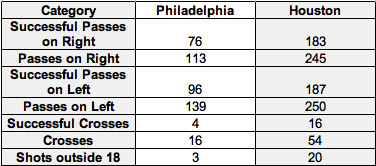Photo: Nicolae Stoian
Ah, the playoffs. They are finally here.
After the dust settled and the endless amount of confusing playoff scenarios were untangled, the Union emerged as the 3rd place team in the Eastern Conference, set to play the Houston Dynamo. But I’m sure you already know that. To jog your memory in case you forgot, the Union were 1-0-1 against the Dynamo this season, with a 1-0 win away and a 1-1 tie at home. To get ready for the two upcoming playoff games against the Dynamo, I have looked at data from the two regular season games to find what the Dynamo’s strengths and weaknesses were against the Union, and what Philadelphia’s strengths and weaknesses have been. All the data are aggregate from the two games played, and are taken from the MLS Chalkboards online.
Wing Play
Because Brad Davis, the Dynamo left midfielder, is Houston’s most dangerous and creative player, I wanted to look at how much each team relies on their flank play. I assumed that the Dynamo would play the wings more and rely more on crosses to create chances. Conversely, I thought the Union would rely more on buildup through the midfield and through balls.
This assumption proved to be correct, and staggeringly so. The chart below shows data on passes on the right side of the field and left side of the field, crosses, and shots outside the 18. (Note: if you’re wondering, I defined a pass on the left as a pass originating from the side of the 18 yard box to the touchline, all the way down the field. The same goes for what I defined as the right side.)
 Clearly, the Dynamo rely heavily on wing play, absolutely crushing the Union in passes and successful passes on both sides of the field. Their domination in crosses in the two games played this year was so significant, I rechecked a couple of times to make sure I was right. 54 crosses to 16. That is over three times as many crosses. With this in mind, the Union must be wary of crosses from the wings, as this is where the majority of Houston chances originate from. Unrelated to wing play, I also noticed that the Dynamo tended to settle for longer shots, taking 20 shots outside the 18 compared to only three from the Union. Just something else to keep in mind.
Clearly, the Dynamo rely heavily on wing play, absolutely crushing the Union in passes and successful passes on both sides of the field. Their domination in crosses in the two games played this year was so significant, I rechecked a couple of times to make sure I was right. 54 crosses to 16. That is over three times as many crosses. With this in mind, the Union must be wary of crosses from the wings, as this is where the majority of Houston chances originate from. Unrelated to wing play, I also noticed that the Dynamo tended to settle for longer shots, taking 20 shots outside the 18 compared to only three from the Union. Just something else to keep in mind.
Brad Davis
As I said before, Brad Davis is the most creative and dangerous player on Houston. Here’s an amazing stat illustrating this: Davis completed ten key passes in the two games he played against the Union this year. In those two games, the entire Union team only completed eight. In case you don’t know, a key pass is a pass that leads to a shot on goal. Yeah, Brad Davis is good.
Blocked Shots
Looking at the stats I listed above you might think that Houston dominated the two games. I originally thought this too, and wanted to figure out how the Union managed to pull out a win and a tie. The answer is the Union’s superb ability to limit shots on goal in the two games played. Below is a chart comparing shots data for the Union and the Dynamo.
 Overall, Philadelphia only took 15 total shots to Houston’s 35. However, The Union managed to get eight of those on goal, while the Dynamo only saw five shots go on target. The Union blocked a whopping 14 of those, and due to defensive pressure or poor play by Dynamo players, 16 of their shots were off target. For the Union, only –seven of their shots were off target, and none of them were blocked. That’s right, the Dynamo did not block any shots in the two games played.
Overall, Philadelphia only took 15 total shots to Houston’s 35. However, The Union managed to get eight of those on goal, while the Dynamo only saw five shots go on target. The Union blocked a whopping 14 of those, and due to defensive pressure or poor play by Dynamo players, 16 of their shots were off target. For the Union, only –seven of their shots were off target, and none of them were blocked. That’s right, the Dynamo did not block any shots in the two games played.
The importance of these numbers cannot be understated. If your team gets all the chances in the world but can’t convert them, then what’s the point? However, if you’re only getting a few chances but convert a large percentage of them, you’re in good shape. Due to the Union defenders’ skill in blocking/forcing shots wide, the Dynamo fell in to the first category. The Union offense fell into the second.
Keys To The Game
Based on these numbers, here are my keys for the Union:
- Be wary of flank play and crosses. Houston is strong there, and that’s where most of their chances are going to originate from.
- Stop Brad Davis. He is the creative force behind their offense, and if you shut him down, their offense will struggle to create chances.
- Block shots. The Union’s ability to limit Houston getting shots on goal was the main reason they only allowed one goal in the two games they played.
- Get shots on goal. If Philadelphia is able to continue to get a lot of shots on target, they are likely to score a lot. If this trend fails, goals will be harder to come by.
Follow me on Twitter for more fun soccer data analysis: @SoccerStatistic


So the passes from the right include passes in the defensive 3rd of the field for each team?
Also, amazed the U don’t have greater number from the wing considering we don’t have a playmaker in the middle of the field. where are our chances coming from? Long balls over the top circa 1980’s high school soccer!!?? LOL
Yes, the passes from the right and from the left include the defensive 3rd of the field. The “right” includes the area touchline to touchline to the right of the box. Same goes for the left. Hope that clears things up.
Also, valid question. I think part of it is that the Union have very high conversion rates for chances, and are able to get a high proportion of shots on goal. In other words, they may not get as many chances, but they are good at converting the few they get.
how are there more successful passes from the left than passes from the left?
“How are there more successful passes from the left than passes from the left?” Because of a typo in making the chart, now corrected. Ford’s commentary, I hope you will agree, remains valid. The Dynamo have a successful pass rate of 69 percent from the left, 67 percent from the right. Scary stuff.